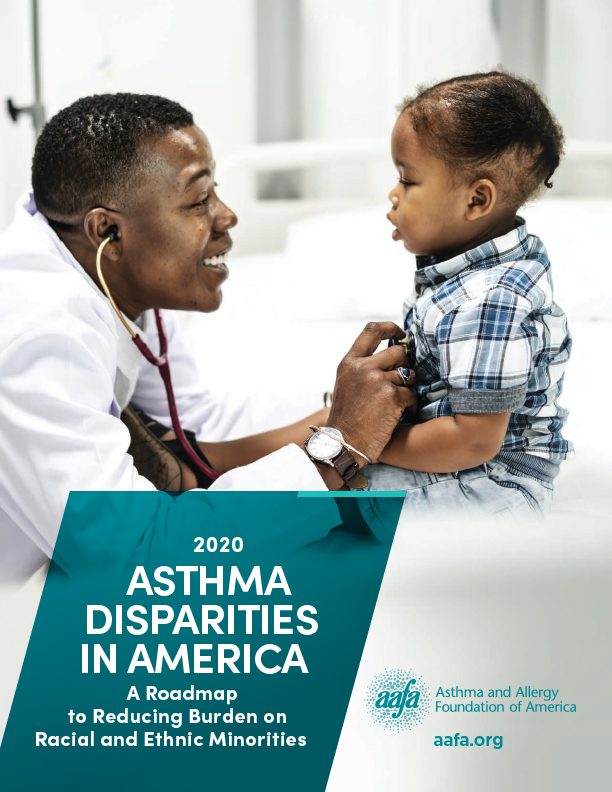Asthma Facts
Asthma Facts and Figures
The burden of asthma in the United States falls disproportionately on people with low-income, senior adults, and Black, Hispanic, and American Indian/Alaska Native people. These groups have the highest asthma rates, deaths, and hospitalizations.
What Is Asthma?
- Asthma is a chronic (long-term) disease that causes inflammation and swelling of the airways. This results in narrowing of the large and small airways that carry air from the nose and mouth to the lungs.
- Asthma symptoms include trouble breathing (shortness of breath), wheezing, coughing, and tightness or pain in the chest.
- Asthma symptoms can be triggered by different things for different people. Allergens, like seasonal pollen, mold spores, dust, or pet dander, are common triggers. Some people also develop asthma symptoms in response to respiratory infections, airway irritants, pollution, weather changes, certain foods, or with exercise.
- Asthma can be deadly if it is not recognized and managed appropriately.
- There is no cure for asthma, but appropriate education and treatment prevents asthma attacks and can help you have a better quality of life.
- Asthma is one of the most common and costly diseases in the United States.
How Common Is Asthma?
- Over 27 million people in the U.S. have asthma. This equals about 1 in 12 people.1,2
- Over 22 million U.S. adults ages 18 and older have asthma.1
- Asthma rates are highest in American Indian or Alaska Native adults in the U.S.1
- Asthma is more common in female adults than male adults. Around 10.8% of female adults have asthma, compared to 6.5% of male adults.1
- It is a leading chronic disease in children.3 Currently, there are about 4.5 million children under the age of 18 with asthma.2
- Non-Hispanic Black children are nearly 2 times more likely to have asthma compared to non-Hispanic White children.2
- Asthma is more common in male children than female children. Around 7.0% of male children have asthma, compared to 5.4% of female children.2
- Asthma is one of the most common and costly diseases in the United States.
What Are the Rates of Asthma Attacks in Children?
- In 2021, 38.7% of children ages 18 and younger who had asthma reported having one or more asthma attacks in the past year.4
- About 63.1% of children under the age of 5 with asthma had an attack.4
- According to the Centers for Disease Control and Prevention (CDC), asthma attacks in children have declined from 2001 through 2020 (from 61% to 43%).5 Even though asthma is controllable, it is estimated that 44% of children with asthma have uncontrolled asthma.6
What Are the Rates of Asthma Attacks in Adults?
- In 2021, 39.6% of adults ages 18 and older who had asthma reported having one or more asthma attacks in the past year.4
- According to the CDC, asthma attacks in adults have declined from 2001 through 2020 (from 54% to 41%).5
How Many People Seek Medical Care for Asthma?
- In 2019, asthma accounted for 4.9 million doctors’ office visits.7
- In 2020, asthma accounted for 94,560 discharges from hospital inpatient care and 986,453 emergency department visits.8
- Black people in the U.S. are nearly 6 times more likely than White people in the U.S. to visit the emergency department due to asthma.8
How Many People Die From Asthma?
- On average, 10 people in the U.S. die from asthma each day. In 2021, 3,517 people died from asthma. Nearly all of these deaths are avoidable with the right treatment and care.9
- In 2020, deaths due to asthma rose for the first time in 20 years. 5
- Adults are 6 times more likely to die from asthma than children.9
- Female adults are more likely to die from asthma than male adults, and male children are more likely than female children.9
- Black people in the U.S. are nearly 3 times more likely to die from asthma than White people in the U.S.9
- When sex is factored in, Black females have the highest rate of fatality due to asthma. In 2021, Black females were more than 3 times more likely to die from asthma than White males.10
What Are the Costs of Asthma?
- From 2008-2013, the annual economic cost of asthma was more than $81.9 billion – including medical costs and loss of work and school days:11
- $3 billion in losses due to missed work and school days
- $29 billion due to asthma-related mortality
- $50.3 billion in medical costs
- Medical costs for people with asthma are estimated to be $3,266 higher per year (in 2015 U.S. dollars) compared to medical costs for people without asthma.11
- Among children ages 5 to 17, asthma is one of the top causes of missed school days. In 2013, it accounted for more than 13.8 million missed school days.12
Why Do Certain Racial or Ethnic Groups Have Higher Rates of Asthma, Asthma Attacks, or Asthma Deaths?
See AAFA’s groundbreaking research report on Asthma Disparities in America. Racial and ethnic differences in asthma frequency, illness, and death are caused by complex factors, including:
- Structural determinants such as systemic racism, segregation, and discriminatory policies
- Social determinants such as socioeconomic status, education, neighborhood and physical environment, employment, social support networks, and access to health care
- Biological determinants such as genes and ancestry
- Behavioral determinants such as tobacco use and adherence to medicines
- Social determinants and structural inequities (systemic racism) largely drive disparities in asthma. Factors such as genetics and individual behaviors contribute less to asthma disparities.
Why Do Males and Females Have Different Rates of Asthma?
- Male children are more likely to have asthma than female children. This trend reverses in adulthood, where female adults are more likely to have asthma than male adults.2
- Some studies suggest this trend reverses because of the effects of testosterone on lung cells. Testosterone, a male sex hormone, has been found to decrease the swelling of the airways in asthma.13
Download PDF
Medical Review: April 2024 by John M. James, MD
References
- National Center for Health Statistics. (2023). 2022 NHIS Adult Summary Health Statistics. U.S. Department of Health and Human Services. https://data.cdc.gov/d/25m4-6qqq
- National Center for Health Statistics. (2023). 2022 NHIS Child Summary Health Statistics. U.S. Department of Health and Human Services. https://data.cdc.gov/d/wxz7-ekz9
- Ferrante, G., & La Grutta, S. (2018). The Burden of Pediatric Asthma. Frontiers in Pediatrics, 6. https://doi.org/10.3389/fped.2018.00186
- Centers for Disease Control and Prevention. (2023). 2021 National Health Interview Survey Data. U.S. Department of Health & Human Services. https://www.cdc.gov/asthma/nhis/2021/data.htm
- Centers for Disease Control and Prevention. (2023). Asthma Data Visualizations. https://www.cdc.gov/asthma/data-visualizations/default.htm
- National Asthma Control Program. (2022). Uncontrolled Asthma Among Children With Current Asthma, 2018–2020. National Center for Environmental Health. https://archive.cdc.gov/#/details?url=https://www.cdc.gov/asthma/asthma_stats/uncontrolled-asthma-children-2018-2020.htm
- National Center for Health Statistics. (2022). National Ambulatory Medical Care Survey: 2019 National Summary Tables. U.S. Department of Health and Human Services, Centers for Disease Control and Prevention. https://www.cdc.gov/nchs/data/ahcd/namcs_summary/2019-namcs-web-tables-508.pdf
- Agency for Healthcare Research and Quality. (2023). Healthcare Cost and Utilization Project 2020 Healthcare Use Data. U.S. Department of Health and Human Services, Centers for Disease Control and Prevention. https://www.cdc.gov/asthma/healthcare-use/2020/data.htm
- Centers for Disease Control and Prevention. (2023). Most Recent National Asthma Data, Mortality. U.S. Department of Health and Human Services. https://www.cdc.gov/asthma/most_recent_national_asthma_data.htm
- National Center for Health Statistics. National Vital Statistics System: Underlying Cause of Death 2018-2021. (2023). U.S. Department of Health and Human Services, Centers for Disease Control and Prevention. https://wonder.cdc.gov/ucd-icd10-expanded.html
- Nurmagambetov, T., Kuwahara, R., & Garbe, P. (2018). The Economic Burden of Asthma in the United States, 2008–2013. Annals of the American Thoracic Society, 15(3), 348–356. https://doi.org/10.1513/annalsats.201703-259oc
- Centers for Disease Control and Prevention. (2015). Asthma-related Missed School Days among Children aged 5-17 years. U.S. Department of Health and Human Services. https://www.cdc.gov/asthma/asthma_stats/missing_days.htm
- Fuseini, H., & Newcomb, D. C. (2017). Mechanisms Driving Gender Differences in Asthma. Current Allergy and Asthma Reports, 17(3). https://doi.org/10.1007/s11882-017-0686-1

Asthma Capitals
Where you live can have an impact on your asthma. AAFA’s Asthma Capitals™ report looks at the top 100 most challenging cities in the continental United States to live with asthma.














